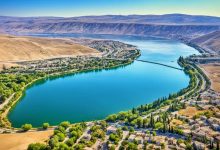The Hula Lake: A Natural Gem of Ecological Significance
Introduction
The Hula Lake, located in northern Israel, is a unique wetland area that holds immense ecological, historical, and cultural significance. Originally a large lake, it has transformed over the years into a vital ecological reserve, showcasing a rich diversity of flora and fauna. This article delves into the history, biodiversity, conservation efforts, and the ultimate importance of Hula Lake in the context of environmental sustainability.
Historical Background
Hula Lake was once part of a larger marshland ecosystem, known as the Hula Valley, which existed for thousands of years. In the mid-20th century, extensive drainage projects aimed at increasing agricultural land resulted in significant changes to the lake’s ecosystem. These modifications led to a decline in biodiversity and the loss of vital habitats for many species. The ecological crisis prompted the government and environmental organizations to take action to restore the area, ultimately designating it as a nature reserve in 1964.
Biodiversity
The Hula Lake and its surrounding wetlands are home to a diverse array of species. This area serves as a critical stopover point for migratory birds along the African-Eurasian flyway. Over 200 species of birds can be observed in the region, including the stunning cranes that arrive in large numbers during the winter months. Other avian inhabitants include herons, ducks, and various raptors, which thrive in the rich ecological landscape.
In addition to avifauna, Hula Lake supports a variety of plant species, ranging from reeds and aquatic plants to trees and shrubs that line the banks. This plant diversity provides essential habitats for numerous animal species, including amphibians, reptiles, and mammals, creating a vibrant and interconnected ecosystem.
Conservation Efforts
Recognizing the ecological importance of Hula Lake, various conservation initiatives have been implemented to restore and preserve the area. The Hula Nature Reserve was established to protect the remaining wetland ecosystems and facilitate the recovery of native species. Restoration efforts include reintroducing native flora, managing water levels, and reducing pollution.
Ecotourism has also played a pivotal role in conservation strategies. The promotion of sustainable tourism not only raises awareness about the ecological importance of Hula Lake but also provides economic benefits to local communities. Visitors are encouraged to engage in birdwatching, guided tours, and educational programs that highlight the significance of preserving this unique habitat.
Ecological Importance
The Hula Lake is not just a sanctuary for wildlife; it also plays a crucial role in the broader ecological health of the region. Wetlands are known for their ability to filter pollutants, store carbon, and regulate water flow. By preserving and restoring Hula Lake, significant progress is made toward combating climate change and maintaining water quality in the surrounding areas.
Moreover, the lake acts as a natural buffer against flooding, absorbing excess rainwater and reducing the risk of flood damage in nearby agricultural lands. Its restoration has led to increased biodiversity, which enhances ecosystem resilience and stability.
Cultural Significance
Beyond its ecological value, Hula Lake carries cultural and historical importance. The region has been inhabited for thousands of years, with archaeological sites revealing evidence of ancient civilizations. The lake itself is mentioned in various historical texts, signifying its importance to early human settlements.
Today, the cultural heritage of the Hula Valley is celebrated through local festivals and educational programs that highlight the relationship between people and the natural environment. This connection fosters a sense of stewardship among residents and visitors alike, encouraging them to participate in conservation efforts.
Challenges and Future Outlook
Despite the successes achieved in restoring Hula Lake, challenges remain. Climate change poses a significant threat, altering precipitation patterns and water availability. Additionally, agricultural runoff continues to impact water quality, necessitating ongoing monitoring and management.
Looking forward, continued collaboration between government agencies, environmental organizations, and local communities is essential. Innovative approaches to sustainable land use and water management can help mitigate these challenges while ensuring the preservation of Hula Lake for future generations.
Conclusion
Hula Lake stands as a testament to the resilience of nature and the importance of conservation efforts. Its rich biodiversity, ecological functions, and cultural significance underscore the need for ongoing protection and restoration. As we delve deeper into understanding our impact on the environment, Hula Lake serves as a model for how collective action can lead to positive change. By prioritizing the preservation of this natural gem, we not only protect a vital ecosystem but also enhance the quality of life for future generations.

